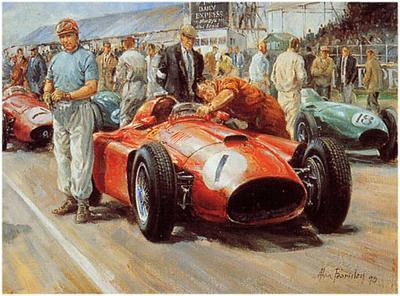

To view other parts of our Ferrari collection take these links to the Ferrari Racing & Prototype Cars of the 1950's, 1960's, 1970's, 1980's to Present,
as well as the GP & F1 Cars and the ProductionSports Cars parts of our Ferrari collection.
| : |
: |
: |
| Ferrari 330 GT 2+2, 330 GTC, 330 GTS: |
: |
: |
: |
To view other parts of our Ferrari collection take these links to the Ferrari Racing & Prototype Cars of the 1950's, 1960's, 1970's, 1980's to Present,
as well as the GP & F1 Cars and the ProductionSports Cars parts of our Ferrari collection.
THE SIGNATURE PROJECT & RACING DIORAMAS
World F1 Champions 1950 - PRESENT
GREAT AUTOMOTIVE MAKES & RACING TEAMS:
AMERICAN:
CHAPARRAL
CHEVROLET & GM POWERED RACE CARS
COBRAS & DAYTONAS - SHELBY CARS
CUNNINGHAM EQUIPE - THE CARS OF BRIGGS CUNNINGHAM
FORD POWER: GT40's, MUSTANGS & MORE
MISC. AMERICAN MADE
BRITISH:
ASTON MARTIN RACE & PRODUCTION
AUSTIN HEALEY & HEALEY
BRABHAM F1 & SPORTS CARS
BRM F1 & SPORTS CARS
LOLA SPORTS RACING CARS
LOTUS F1, RACE & PRODUCTION
McLAREN RACING & PRODUCTION CARS
MG CARS - RACING & PRODUCTION
TRIUMPH RACE & PRODUCTION CARS
MISC. BRITISH MADE
FRENCH:
BUGATTI
FRENCH MADE
GERMAN & SWEDISH:
AUDI RACING
BMW RACE & PRODUCTION
MERCEDES BENZ RACE & PRODUCTION
MISC. GERMAN & SWEDISH MADE
ITALIAN & SPANISH:
ABARTH RACING
ALFA ROMEO RACE & PRODUCTION
LANCIA RACE & PRODUCTION
MASERATI RACE & PRODUCTION
MISC. ITALIAN & SPANISH MADE
ASIAN & AUSTRALIAN:
DATSUN/NISSAN RACING
TOYOTA RACE & PRODUCTION CARS
MISC. JAPAN, ASIAN & AUSTRALIAN MADE
VETERAN, CLASSIC & SPECIAL INTEREST CARS All MARQUES
LAND SPEED AND ENDURANCE RECORD CARS LE MANS THE PINACLE OF ENDURANCE RACES: HALL OF FAME DRIVER TRIBUTES: PLAY BALL! - IT'S BASEBALL TIME:
For copies of images, questions or comments about the collection to: OLD IRISH RACING
Back to: OLD IRISH RACING MODELS INDEX Home Page
Back to: OLD IRISH RACING Home Page Legal stuff: Content and images on this website unless stated, are the property and content of Old Irish Racing and may not be used without permission. Old Irish Racing is not affiliated with, or represent any other entity past or present.
PLEASE NOTE: From 1968 into the 1990's tobacco companies sponsored many significant race cars. We don't promote tobacco use, rather we stronly discourage it. However, we do promote historical accuracy, Old Irish Racing chooses
to display models in our collection as historically accurate as possible. While seeing a tobacco advert on a car gives me no more desire to go smoke than seeing a car makes me want to go
suck on its exhaust pipe. If tobacco (or alcohol) adverts on race cars offend you, please go look at nice pictures of bunnies and kittens on another site. Thank you!
THE 24 HOURS of LE MANS 100 YEARS - 1923-2023
THE OLD IRISH RACING HALL OF FAME
A TRIBUTE TO BOYHOOD HEROES AND MY DAD
All pages and content on this website (unless noted) are owned and the copyrighted and may not be reproduced or redistributed without the consent of Old Irish Racing. This is a private collection, unless noted, pieces are not for sale!